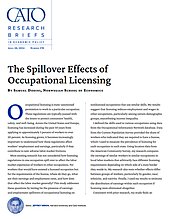Most existing research has not considered how licensing regulations in one occupation spill over to affect the labor market experience of workers in other occupations. For workers that would have entered a licensed occupation but for the requirements of the license, where do they go, what are their earnings and employment rates, and how does that affect the labor market generally? This study addresses these questions by testing for the presence of earnings and employment spillovers of occupational licensing on nonlicensed occupations that use similar skills. My results suggest that licensing reduces employment and wages in other occupations, particularly among certain demographic groups, exacerbating income inequality.
I defined the skills used in various occupations using data from the Occupational Information Network database. Data from the Current Population Survey provided the share of workers who indicated they are required to have a license, which I used to measure the prevalence of licensing for each occupation in each state. Using location data from the American Community Survey, my research compares the earnings of similar workers in similar occupations in local labor markets that arbitrarily face different licensing requirements depending on which side of a state border they reside in. My research also tests whether effects differ between groups of workers, particularly by gender, race/ethnicity, and nativity. Finally, I used my results to estimate the distribution of earnings within each occupation if licensing were eliminated altogether.
Consistent with prior research, my study finds an average earnings premium of approximately 8 percent in occupations required to have a license in their state relative to the same occupation without a licensing requirement on the other side of a state border. Conversely, my study finds that a 10 percentage point increase in the share of licensed workers with similar skills is associated with earnings that are 1.6–2.3 percent lower for all occupations. These negative effects are stronger for female, non‐Hispanic black, and foreign‐born Hispanic workers and are most concentrated in industries outside agriculture, manufacturing, and mining. Because these demographic groups are in the lower portion of the income distribution, these effects imply that licensing contributes to local income inequality. My estimates suggest that eliminating occupational licensing would reduce earnings inequality within occupations by 2–4 percent across various measures, such as the 90:10 and 10:50 percentile earnings ratios, and that the Gini coefficient within occupations would fall by as much as 7 percent. Eliminating licensing would increase mean earnings, particularly for black workers. My results suggest that for every extra $1.00 that a worker earns via the licensing premium of their own occupation, they lose approximately $2.23 via spillover effects from other licensed occupations.
Finally, my research estimates the effects of licensing on local labor market employment levels and on the demographic composition in each occupation. The direction of the employment effect helps explain why licensing has spillover effects on earnings. Licensing can reduce other occupations’ wages by raising barriers to entry in one occupation, thus redirecting labor supply to unlicensed occupations. However, my research finds no evidence of this effect. Instead, it finds a decline in employment in each occupation due to licensing in other occupations. It also finds that as similar occupations become more licensed, the share of female workers in an occupation falls, as does workers’ average years of completed education. Moreover, the share of workers in each occupation that is Hispanic or foreign‐born rises. These demographic changes may account for about one‐third of the decreased earnings.
How can licensing in some occupations reduce wages and employment in other occupations? First, existing research suggests that firms avoid costly licensing rules by opening fewer locations in licensed jurisdictions, driving down local demand for labor. My research finds some reduction in labor demand in more licensed industries, but licensing intensity is not associated with widespread drops in labor demand in the local economy. Second, decreased employment in licensed occupations might reduce employment in occupations that complement licensed occupations. My results suggest that this effect is limited. Third, licensing may make it more difficult for workers to change occupations. Firms facing less competition from licensed occupations for workers may choose to hire fewer workers and pay lower wages because workers have a smaller pool of other occupations to which they could credibly threaten to go. For example, consider a worker who can choose to work as a waiter or a barber. If being a barber requires a license (and being a waiter does not), then restaurants may be able to pay waiters less without concern they will quit to become a barber. My analysis provides evidence that this effect is a likely explanation.
Raising barriers to entry across more and more occupations has unintended consequences for workers. While some may be better off individually once they get a license, strict entry regulations may leave others worse off. These tradeoffs between the possible benefits of licensing to consumers and the costs to workers should be seriously considered in local, state, and federal policy conversations.
NOTE
This research brief is based on Samuel Dodini, “The Spillover Effects of Labor Regulations on the Structure of Earnings and Employment: Evidence from Occupational Licensing,” Journal of Public Economics 225 (September 2023).

